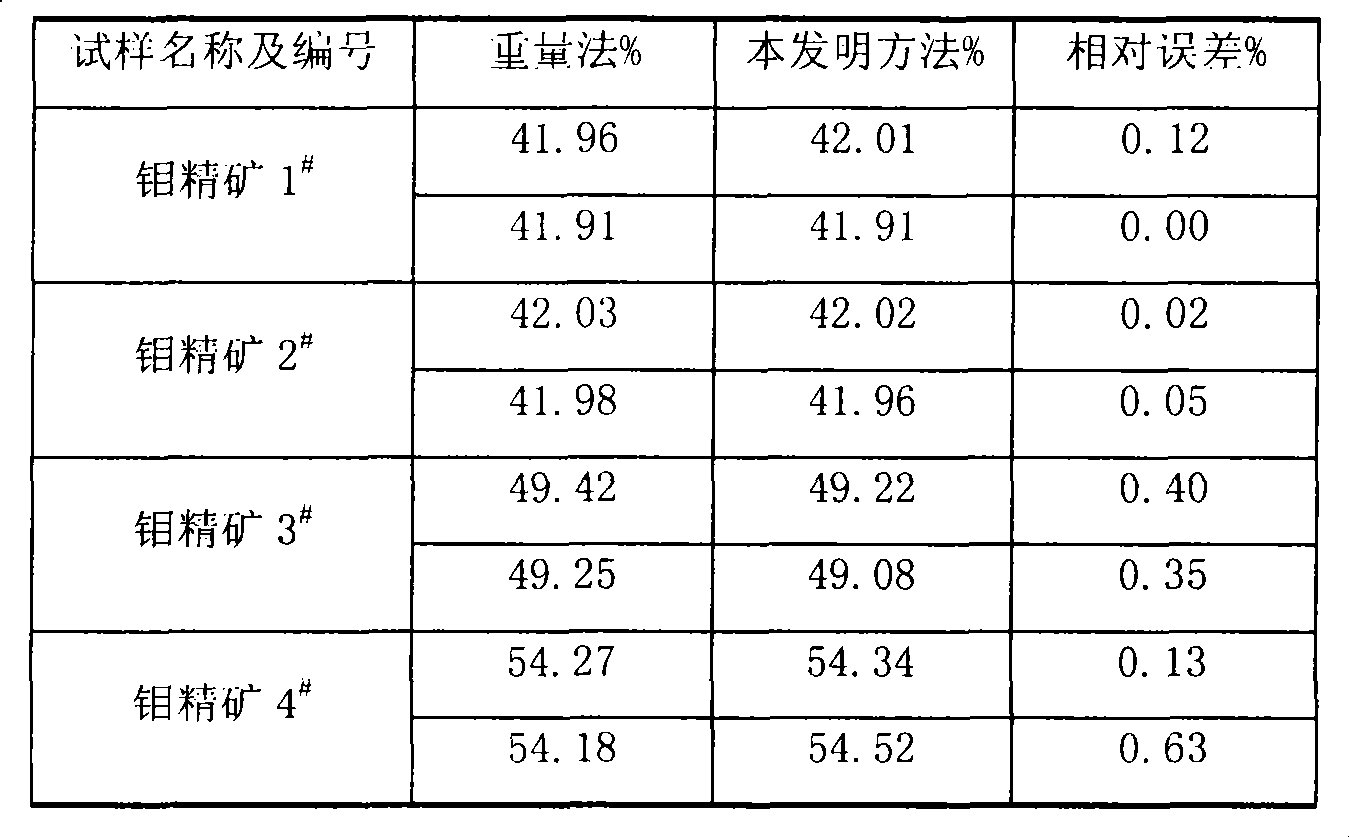Fast analysis method of molybdenum in molybdenum concentrate
A rapid analysis, molybdenum concentrate technology, applied in the preparation of test samples, measurement of color/spectral properties, etc., can solve problems such as difficulty in molybdenum determination, achieve good accuracy and precision, simple procedures, and easy operation. Effect
- Summary
- Abstract
- Description
- Claims
- Application Information
AI Technical Summary
Problems solved by technology
Method used
Image
Examples
Embodiment 1
[0018] Weigh 0.4005g of sample into a beaker, add about 20ml of nitric acid and 0.5g of potassium chlorate, cover with a watch glass, heat to dissolve and evaporate to a volume of about 5ml, after cooling slightly, add 10ml of hydrochloric acid, evaporate to 5ml, then add 10ml of hydrochloric acid, Evaporate to 5ml, cool to room temperature, add 20-25ml of water to rinse the watch glass and beaker wall, boil to dissolve the salt completely, add 8ml of 50% (weight) sodium hydroxide solution, heat to boil for 2min, remove and cool After reaching room temperature, transfer to a 100ml volumetric flask and dilute to volume with water. Dry filter with medium-speed quantitative filter paper, take 20.00ml of the filtrate into a beaker, add 1 drop of 0.5% phenolphthalein indicator, neutralize with hydrochloric acid (1+1) until the red color disappears and add 2 drops of excess, add 20ml of phenolphthalein with a pH of 5-7 Acetic acid-ammonium acetate buffer solution, heated to slightly...
Embodiment 2
[0020] Weigh 0.4123g sample into a beaker, add about 20ml nitric acid and 0.5g potassium chlorate, heat to dissolve and evaporate to a volume of about 5ml, after cooling slightly, add 10ml hydrochloric acid, evaporate to 5ml, then add 10ml hydrochloric acid, evaporate to 5ml, cool After reaching room temperature, add 20-25ml of water to rinse the watch glass and the wall of the beaker, boil to dissolve the salt completely, add 8ml of 50% (weight) sodium hydroxide solution, heat and boil for 2min, remove and cool to room temperature, then transfer to 100ml capacity Bottle, made up to volume with water. Dry filter with medium-speed quantitative filter paper, take 20.00ml of filtrate in a beaker, add 1-2 drops of 0.1% methyl orange indicator, neutralize with hydrochloric acid (1+1) until the solution changes from orange yellow to red, and add 2 drops in excess , add 15mL of acetic acid-sodium acetate buffer solution with pH=5-7, heat to a slight boil, take it off, slowly add 110....
Embodiment 3
[0022] Weigh 0.4376g of sample into a beaker, add about 20ml of nitric acid and 0.5g of potassium chlorate, cover with a watch glass, heat to dissolve and evaporate to a volume of about 5ml, after cooling slightly, add 10ml of hydrochloric acid, evaporate to 5ml, then add 10ml of hydrochloric acid, Evaporate to 5ml, after cooling to room temperature, add 20-25ml of water to rinse the watch glass and the beaker wall, boil on an electric stove to completely dissolve the salt, add 8ml of 50% (weight) sodium hydroxide solution, heat and boil for 2min, take After cooling down to room temperature, transfer to a 100ml volumetric flask and dilute to volume with water. Dry filter with medium-speed quantitative filter paper, take 20.00ml of the filtrate into a beaker, add 1 drop of 0.5% phenolphthalein indicator, neutralize with hydrochloric acid (1+1) until the red color disappears and add 2 drops of excess, add 25mL of phenolphthalein with a pH of 5-7 Acetic acid-ammonium acetate buff...
PUM
 Login to View More
Login to View More Abstract
Description
Claims
Application Information
 Login to View More
Login to View More - R&D
- Intellectual Property
- Life Sciences
- Materials
- Tech Scout
- Unparalleled Data Quality
- Higher Quality Content
- 60% Fewer Hallucinations
Browse by: Latest US Patents, China's latest patents, Technical Efficacy Thesaurus, Application Domain, Technology Topic, Popular Technical Reports.
© 2025 PatSnap. All rights reserved.Legal|Privacy policy|Modern Slavery Act Transparency Statement|Sitemap|About US| Contact US: help@patsnap.com

